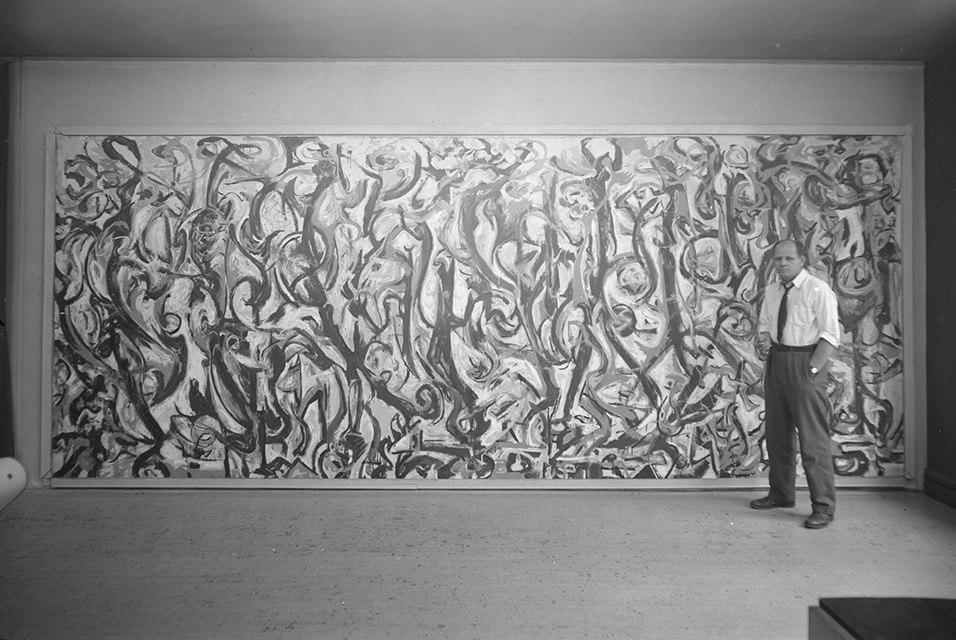MFA Boston commissions Katharina Grosse to create work to pair with Jackson Pollocks Mural

artdaily_BOSTON, MASS.- A new exhibition at the Museum of Fine Arts, Boston, Mural: Jackson Pollock | Katharina Grosse, presents an unprecedented pairing: the largest painting ever made by Jackson Pollock (1912–1956) and a new, site-related work by German artist Katharina Grosse (born in 1961). Commissioned by art patron and gallerist Peggy Guggenheim and later donated to the University of Iowa Stanley Museum of Art, Pollock’s Mural (1943) stretches nearly 20 feet wide by eight feet high. Today, it is recognized as one of the pivotal achievements of the artist’s career, the moment when he left figuration behind, expanded the scale of his work and started to develop the drip technique of applying paint to canvas that would become his signature. On view in Boston for the first time, Mural is displayed at the MFA alongside Grosse’s Untitled (2019), a free-hanging painting 48 feet wide by 16 feet high, which bursts with sweeping streaks of kaleidoscopic color. Deeply saturated with layered pigments that flow into each other and soak through the cloth, Untitled offers a vivid sensory experience on both sides and is made to be enjoyed in the round. Together, the works demonstrate how each artist has respectively transformed painting through innovative techniques and unique approaches to color on a massive scale. Curated by Zoë Samels, Curatorial Research Associate, Art of the Americas, and Akili Tommasino, Associate Curator, Modern and Contemporary Art, Mural: Jackson Pollock | Katharina Grosse is on view from July 1, 2019 through February 23, 2020 in the Charlotte F. and Irving W. Rabb Gallery.
Born in Wyoming and raised in California, Pollock studied art in high school before enrolling in painter Thomas Hart Benton’s classes at the legendary Art Students League in New York City. His earliest works were in the Romantic landscape tradition, populated with stylized figures that echo Benton’s work. Soon, however, these pictures gave way to a more turbulent style, marked by jagged lines, harsh and acid colors, and imagery that was symbolic, enigmatic and abstract. Pollock was still a relatively unknown artist when Guggenheim commissioned him to create a work of art for the foyer of her Manhattan townhouse in the summer of 1943. He painted Mural with bold brushstrokes that appear to dance rhythmically across the dense and vibrant surface, and declared it a hybrid form of composition that was both a mural and an easel painting. The work was installed in January 1944 and immediately caused a sensation in the art world. “I took one look at it,” the influential critic Clement Greenberg later said, “and I knew that Jackson was the greatest painter this country had produced.” Following the creation of Mural, Pollock continued to experiment with painting on large canvases and embrace the visual language of pure abstraction. Four years later, in 1947, he embarked on making the works for which he has become best known: his so-called “drip” paintings, in which he dripped, dribbled and poured paint directly onto unstretched canvas. Those works cemented his reputation as one of the most important artists of the 20th century.
Like Pollock, Grosse breaks with the long tradition of the mural, which historically describes a painting made directly on, or permanently affixed to, a wall. Born in Freiburg im Breisgau, Germany, she began painting at an early age and is now recognized as one of the most important painters of her generation. Since the late 1990s, she has sprayed prismatic swaths of color directly onto architectural structures, objects and landscapes, creating immersive visual experiences that erode the distinction between two and three dimensions and radically expand the scope of painting. Commissioned by the MFA and painted in her studio in Berlin, Untitled is the latest in Grosse’s recent series of free-hanging works that further investigate painting’s potential to live off the wall and to respond to and confront the world in novel ways. Shown perpendicular to Pollock’s Mural, its three floating cloth panels bisect the gallery and suggest a mural without walls.
